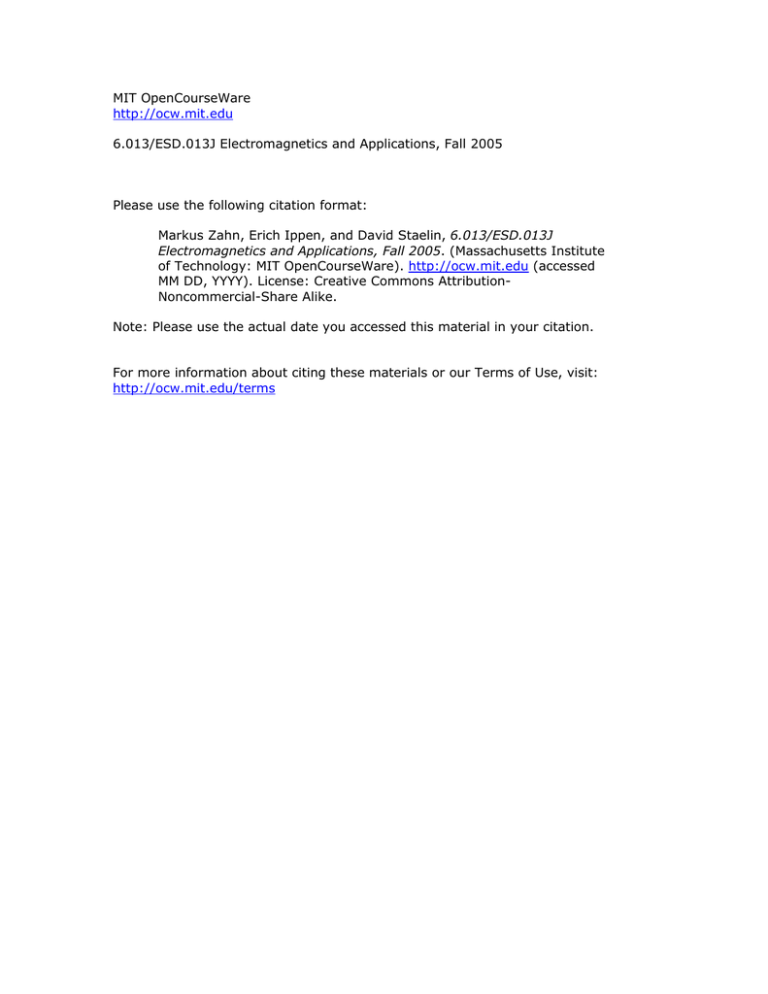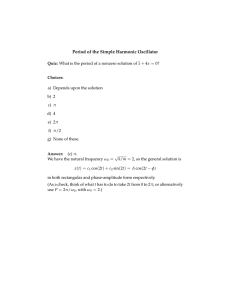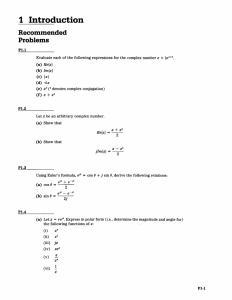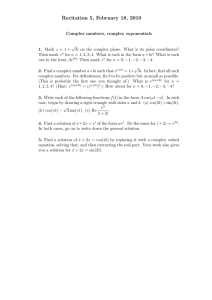MIT OpenCourseWare 6.013/ESD.013J Electromagnetics and Applications, Fall 2005
advertisement

MIT OpenCourseWare
http://ocw.mit.edu
6.013/ESD.013J Electromagnetics and Applications, Fall 2005
Please use the following citation format:
Markus Zahn, Erich Ippen, and David Staelin, 6.013/ESD.013J
Electromagnetics and Applications, Fall 2005. (Massachusetts Institute
of Technology: MIT OpenCourseWare). http://ocw.mit.edu (accessed
MM DD, YYYY). License: Creative Commons AttributionNoncommercial-Share Alike.
Note: Please use the actual date you accessed this material in your citation.
For more information about citing these materials or our Terms of Use, visit:
http://ocw.mit.edu/terms
6.013/ESD.013J — Electromagnetics and Applications
Fall 2005
Problem Set 3 - Solutions
Prof. Markus Zahn
MIT OpenCourseWare
Problem 3.1
A
The idea here is similar to applying the chain rule in a 1D problem:
�
� � �
�� � �
d
1
d
1
df
f � (x)
=
=− 2
,
dx f (x)
df f (x)
dx
f (x)
where f (x) corresponds to |r − r� |.
So, by differentiating f (x) we get part of the answer to the derivative of 1/f (x). But, we can just do it
directly:
�
|r − r� | = (x − x� )2 + (y − y � )2 + (z − z � )2
�
�
�
�
�
�
�
�
1
∂
1
∂
1
∂
1
�
= êx
+ êy
+ êz
|r − r� |
∂x |r − r� |
∂y |r − r� |
∂z |r − r� |
So, we can apply the trick above by just considering x, y, and z components separately.
�
∂ ��
∂
|r − r� | =
(x − x� )2 + (y − y � )2 + (z − z � )2
∂x
∂x
x − x�
= �
(x − x� )2 + (y − y � )2 + (z − z � )2
x − x�
=
|r − r� |
Similarly:
∂
|r − r� | =
∂y
∂
|r − r� | =
∂z
y − y�
|r − r�
|
z − z�
|r − r� |
We have
|r − r� |2 = (x − x� )2 + (y − y � )2 + (z − z � )2 ,
so:
�
�
1
|r − r� |
�
=
−[(x − x� ) êx + (y − y � ) êy + (z − z � ) êz ]
[(x − x� )2 + (y − y � )2 + (z − z � )2 ]3/2
The denominators are clearly |r − r� |3 , thus
�
�
(r − r� )
1
(r − r� )
1
�
=
−
=
−
|r − r� |
|r − r� |3
|r − r� |2 |r − r� |
êr� r
=−
|r − r� |
2
1
Problem Set 3
6.013, Fall 2005
B
This follows from part A immediately by substitution. Remember � is derivatives in terms of the unprimed
coordinates x, y, and z; � does not operate on x� , y � , or z � .
C
�
λ0 a dφ�
ρ(r� ) dV �
=
Φ(r) =
�
4πε0 (a2 + z 2 )1/2
V � 4πε0 |r − r |
where we consider the infinitesimal charges dq = (a dφ)λ0 around the ring.
�
y
x
dφ a
adφ
Figure 1: Diagram for Problem 3.1 Part C. Differential length adφ in a circular hoop of line charge. (Image
by MIT OpenCourseWare.)
We only care about the z-axis in the problem, so, by symmetry, there is no field in the x and y directions.
� 2π
λ0 (a dφ)
,
Φ(r) =
2
2 1/2
4πε
0 (a + z )
0
where (a2 + z 2 )1/2 is the distance from the charge λ0 a dφ to the point z on the z-axis.
Φ(r) =
2ε0
λ0 a
on the z-axis
+ z 2 )1/2
(a2
Check the limit as z → ∞
λ0 a
q2
Φ(z → ∞) =
=
(same form as point charge where q2 = λ0 2πa) �
2ε0 |z |
4πε0 |z |
Now,
0
0
�
�
∂ Φ�
∂Φ
∂
λ0 a
∂ Φ�
) = −êz
E = −�Φ(r) = −(êx � + êy � + êz
∂z
∂z 2ε0 (a2 + z 2 )1/2
�∂x
�∂y
E = êz
aλ0 z
2ε0 (a2 + z 2 )3/2
Again, we check the limit as z → ∞ :
�
�
êz
êz 2ελ00za2 ; z > 0
E(z → ∞) =
=
−λ0 a
ê
êz 2ε
;
z
<
0
z
2
0z
q2
4πε0 z 2 ;
−q2
4πε0 z 2 ;
2
z>0
z<0
(same form as point charge)
Problem Set 3
6.013, Fall 2005
D
From part C
Φ=
2ε0
λ0 r
+ z 2 )1/2
(r 2
for a ring of radius r. But now we have σ0 , not λ0 . How do we express λ0 in terms of σ0 ?
a
r
dr
Figure 2: Diagram for Problem 3.1 Part D. Finding the scalar electric potential and electric field of a charged
circular disk by adding up contributions from charged hoops of differential radial thickness. (Image by MIT
OpenCourseWare.)
Take a ring of width dr in the disk (see figure). We have
Total charge = (r)(2π)(dr)σ0
� �� �
circum.
Line charge density = λ0 =
total charge
= σ0 dr
length
So, λ0 = σ0 dr and
dΦ =
σ0 r dr
2ε0 (r 2 + z 2 )1/2
Integrating gives
� a
Φtotal =
σ0 r dr
σ0
=
2 + z 2 )1/2
2ε
2ε
(r
0
0
0
�
σ0 � � 2
=
a + z 2 − |z|
2ε0
E = −�Φtotal =
�
0
a
�r=a
σ0 � � 2
r dr
2
r
+
z
=
2ε0
r=0
(r 2 + z 2 )1/2
�
�
1
σ0 z 1
êz
−√
2ε0 |z |
a2 + z 2
√
a2 + z 2 can be neglected, so:
�
Φtotal (a → ∞) = − 2σε00 (z − a)
z > 0, just like sheet charge
E(a → ∞) = −�Φ
= êz 2σε00
As a → ∞, z in
3
Problem Set 3
6.013, Fall 2005
Problem 3.2
A
(x,y,z)
z r
+
d
2
d
2
+q
r
r-
x
-q
Figure 3: Diagram for Problem 3.2 Part A. (Image by MIT OpenCourseWare.)
We can simply add the potential contributions of each point charge:
q
q
−
,
4πε0 r+
4πε0 r−
�
�2
�
d
2
2
r+ = x + y + z −
2
�
�
�2
d
r − = x2 + y 2 + z +
2
Φ=
⎡
⎤
1
1
q ⎣
⎦
�
Φ=
� −�
�
�
�
4πε0
d 2
d 2
2
2
2
2
x +y + z− 2
x +y + z+ 2
B
z
d
2
d
2
+q
z
r+
r
r-
θ
x
r+
r
rx
a= d cosθ
2
-q
Figure 4: Diagrams for Problem 3.1 Part B. (Image by MIT OpenCourseWare.)
p = qd, where p is the dipole moment. We must make some approximations. As r → ∞, r+ , r− , and r
4
Problem Set 3
6.013, Fall 2005
become nearly parallel. Thus:
d
r+ ≈ r − a = r − cos θ
2 �
�
d
r+ ≈ r 1 −
cos θ .
2r
Similarly,
�
�
d
cos θ
r− ≈ r 1 +
2r
By part A,
Φ=
�
�
q
1
1
.
−
4πε0 r+
r−
If |x| � 1, then 1/(1 + x) ≈ 1 − x. In addition,
�
�
�d
�
� cos θ � � 1,
� 2r
�
so
�
1
1
1
1
≈
1+
≈
d
r+
r 1 − 2r
r
cos θ
�
1
1
1
1
1−
≈
≈
r−
r 1 + 2dr cos θ
r
=⇒
1
1
1d
d
−
≈
cos θ = 2 cos θ
r+
r−
rr
r
Φ≈
qd cos θ
p cos θ
=
4πε0 r 2
4πε0 r 2
d
cos θ
2r
d
cos θ
2r
�
�
C
∂Φ
1 ∂Φ
1 ∂Φ
êr −
êθ −
êφ
∂r
r ∂θ
r sin θ ∂φ
p cos θ
∂Φ
p sin θ
∂Φ
∂Φ
=−
,
=−
,
=0
∂r
2πε0 r 3
∂θ
4πε0 r 2
∂φ
1 p sin θ
p cos θ
êr +
êθ
E=
3
2πε0 r
r 4πε0 r 2
p
[2 cos θ êr + sin θ êθ ]
E=
4πε0 r 3
E = −�Φ = −
D
Er
2 cos θ
1 dr
=
=
= 2 cot θ
r dθ
Eθ
sin θ
�
�
1
1
dr = 2 cot θ dθ =⇒
dr = 2 cot θ dθ
r
r
ln r = 2 ln(sin θ) + k =⇒ r = r0 sin2 θ (when θ = π/2, r = r0 )
r
= sin2 θ
r0
5
Problem Set 3
6.013, Fall 2005
Figure 5: The potential at any point P due to the electric dipole is equal to the sum of potentials of each
charge alone. The equi-potential (dashed) and field lines (solid) for a point electric dipole calibrated for
4πε0 /p = 100.
In[1]:=
In[2]:=
In[3]:=
In[4]:=
<<Graphics‘Graphics‘
r[ro_,theta_]:= ro*Sin[theta]^2
theta2 = Pi/2 - theta
eplot = PolarPlot[r[.25, theta2], r[.5, theta2], r[1, theta2], r[2, theta2]
{theta, 0, 2*Pi}, PlotRange -> All]
6
Problem Set 3
6.013, Fall 2005
Out[4]=
θ
0.75
0.5
0.25
-2
r0 = 1
r0 = .5
1
-1
r0 = 2
2
E Field Lines
-0.25
-0.5
-0.75
r0 = 0.25
Figure 6: Mathematica Plot 1 – Electric field lines (Image by MIT OpenCourseWare.)
In[5]:= rp[phi_,theta_]:= Sqrt[Abs[Cos[theta]/(100*Phi)]]
In[6]:= pplot = PolarPlot[{rp[0.0025, theta2], rp[.01, theta2],
rp[.04, theta2], rp[.16, theta2], rp[.64, theta2], rp[2.56, theta2],
rp[10.24, theta2], rp[40.96, theta2]}, {theta, -Pi, Pi}, PlotRange -> All]
Out[6]=
Φ = .0025 Equipotential
Lines
2
1
Φ = .01
Φ = 0.04
Φ = .16
-1
-0.5
0.5
1
Φ=0
-1
-2
Figure 7: Mathematica Plot 2 – Equipotential lines (Image by MIT OpenCourseWare.)
In[7]:= tplot = Show[eplot, pplot]
7
Problem Set 3
6.013, Fall 2005
Out[7]=
Figure 8: Mathematica Plot 3 – Electric field and equipotential Lines (Image by MIT OpenCourseWare.)
Problem 3.3
A
The bird acquires the same potential as the line, hence has charges induced on it and conserves charge when
it flies away.
B
The fields are those of a charge Q at y = h, x = U t and an image at y = −h and x = U t.
C
The potential is the sum of that due to Q and its image −Q.
�
�
1
Q
1
�
Φ=
−�
4πε0
(x − U t)2 + (y − h)2 + z 2
(x − U t)2 + (y + h)2 + z 2
D
From this potential
Ey = −
Q
∂Φ
=
∂y
4πε0
�
y−h
y+h
−
2
2
2
3/2
2
[(x − U t) + (y − h) + z ]
[(x − U t) + (y − h)2 + z 2 ]3/2
8
�
.
Problem Set 3
6.013, Fall 2005
Thus, the surface charge density is
�
�
Qε0
−h
h
σ0 = ε0 Ey |y=0 =
−
4πε0 [(x − U t)2 + h2 + z 2 ]3/2
[(x − U t)2 + h2 + z 2 ]3/2
−Qh
=
2π[(x − U t)2 + h2 + z 2 ]3/2
E
The net charge q on the electrode at any given instant is
� w � l
−Qh dxdz
q=
.
2π[(x
−
U t)2 + h2 + z 2 ]3/2
z=0 x=0
If w � h,
q=
�
l
x=0
−Qhw dx
.
2π[(x − U t)2 + h2 ]3/2
For the remaining integration, x� = (x − U t), dx� = dx, and
� l−Ut
−Qhw dx�
q=
.
�2
2 3/2
−Ut 2π[x + h ]
Thus,
�
�
Qw
l − Ut
Ut
�
q=−
.
+�
2πh
(l − U t)2 + h2
(U t)2 + h2
The dashed curves (1) and (2) in the figure 9(a) below are the first and second terms in the above equation.
They sum to give (3).
q
v
(1)
(2)
l
Ut
(3)
l /U
(a)
t
(b)
Figure 9: Curves for Problem 3.3 Part E. The net charge (a) and voltage (b) as a function of time on the
electrode in the y = 0 plane. (Image by MIT OpenCourseWare.)
F
The current follows from the expression for q as
�
�
dq
Qw
−U h2
U h2
i=
=−
+
dt
2πh [(l − U t)2 + h2 ]3/2
[(U t)2 + h2 ]3/2
and so the voltage is then V = −iR = −R dq/dt. A sketch is shown in figure 9(b) above.
9
Problem Set 3
6.013, Fall 2005
Problem 3.4
Figure 10: Diagram for Problem 3.4. The image current from a line current Iêz a distance d above a perfect
conductor. (Image by MIT OpenCourseWare.)
A
By the method of images, the image current is located at (0, −d) with the current I in the opposite direction
of the source current.
For a single line current I at the origin, the magnetic field is
H=
I
I
êφ =
(−y êx + x êy ).
2πr
2π(x2 + y 2 )
Use the superposition for a current I in the +z direction at y = d so that y is replaced by y − d and for the
current −I in the −z direction at y = −d so that y is replaced by y + d. Then
Htotal =
I
I
(−(y − d) êx + x êy ) −
(−(y + d) êx + x êy )
2π(x2 + (y − d)2 )
2π(x2 + (y + d)2 )
B
The surface current at the y = 0 surface is
Kz = −Hx |y=0+ =⇒ K =
−Id
êz
π(x2 + d2 )
C
The total current flowing on the y = 0 surface is
�
� +∞
� ���+∞
−Id êz 1
1
−Id êz +∞
−1 x �
dx
=
tan
= −I ˆ
ez .
Itotal = êz
Kz dx =
2
2
π
π
d
d �−∞
−∞ (x + d )
−∞
D
The force per unit length on the current I at y = d comes from the image current at y = −d
F = (I êz ) × (µ0 H(x = 0, y = d)) =
µ0 I 2
êy .
4πd
10


